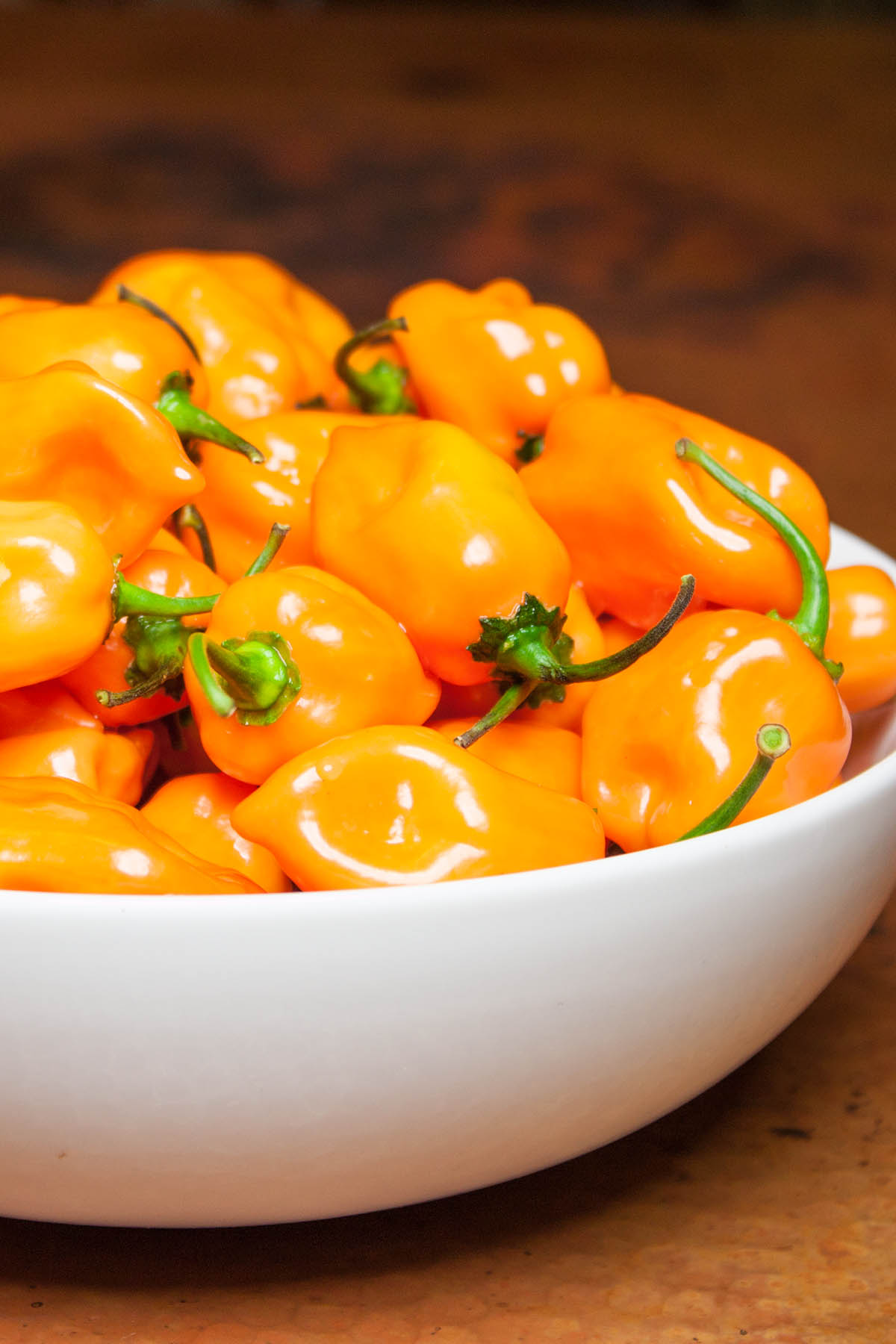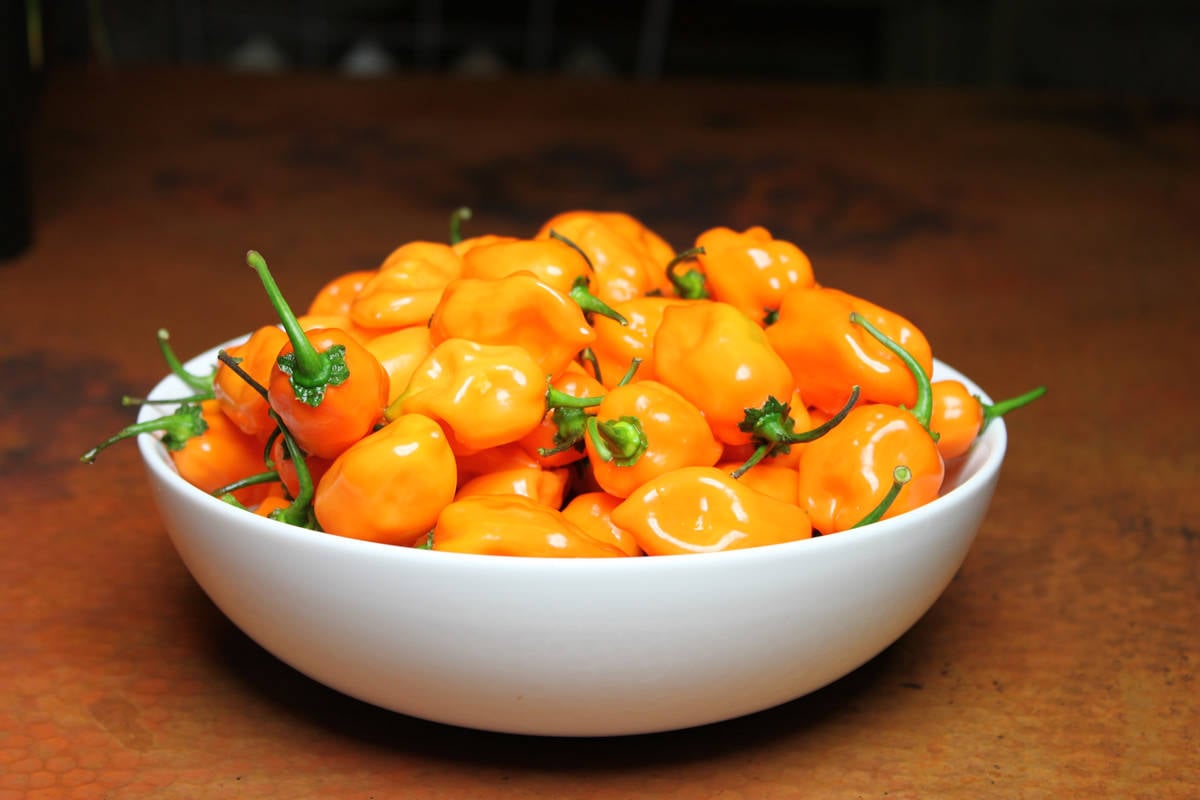This post was updated on 11/30/21 to include new information and photo. It was originally published on 10/7/13.
What is a Habanero Pepper?
The habanero pepper is a fiery chili pepper with a fruity, citrusy flavor. It is prized for it’s level of heat, making it popular for making hot sauces, spicy salsas, and infusing both heat and flavor into many dishes. The peppers pods are small, typically 1-2 inches wide. They start off green on the habanero plants, but mature to a vibrant orange or red, depending on the variety. It is named after the Cuban city of La Habana, known in the U.S. as Havana, because it used to feature in heavy trading there. Once the Spanish discovered it, they spread it far and wide around the world, so much so that taxonomists in the 18th century thought it originated in China and therefore named it “Capsicum chinense” or the “Chinese pepper.” If anything, this pepper’s popularity is even more on the rise today. With its terrific heat, its hint-of-citrus and fruity flavor and its flowery aroma, it has become a well-loved ingredient in many preparations including hot sauces and other spicy foods. In Mexico, it is sometimes soaked in tequila or mezcal bottles for days or even weeks in order to make drinks even more fiery. This amazing pepper’s origins go back 8,500 years to the South American rain forests of Brazil, where the Mayans brought them up through Central American to Mexico. They are wildly popular in Mexico, now deeply ingrained in their culture. Yucatan, Mexico, is the largest producer of habanero peppers in the world, exporting them all over the world. You can grow habaneros perfectly in the Yucatan climate, with its unique soil and blazing sun. Because of this, the peppers grown in the Yucatán peninsula are superior to those grown anywhere else in the world. Its size ranges from 1 to 2 1/2 inches in length and from 1 to 2 inches in diameter, and its shape, like that of the Scotch bonnet pepper, can be compared to that of a Scottish Tam o’ Shanter hat. The pepper flesh is thin and waxy. While many range from an eye-watering 200,000 to 300,000 Scoville Heat Units, some have ranged from a scorching 450,000 to a blistering 600,000 Scovilles, thus knocking the socks off of a common jalapeño pepper that usually ranks from 2,500 to 8,000 Scovilles. As a comparison, bell peppers have 0 Scoville Heat Units. Also compare it to the extremely fiery ghost pepper, one of the super hots, which is just about 1 Million Scovilles, or the trinidad moruga scorpion, measuring in at 2 Million SHU. It had quite a respectable heat. To decrease the heat before adding it to your dishes, you can remove the inner white placental tissue. The heat is not in the pepper seeds. Wear gloves when handling.
Habanero Pepper Weights & Measurements
How Much Does a Habanero Pepper Weigh? An average habanero weighs about 1/3 ounce, or 9 grams. How Many Habanero Peppers Per Pound? There are roughly 3 average sized habanero peppers per ounce, and 48-54 habanero peppers per pound. They are cultivated and crossed for these particular characteristics, particularly for variations in heat. Here are some of those variations:
Mild or Sweet Red, Orange, Peach, Black Habanero Orange Caribbean Red Habanero Condor’s Beak Big Sun Golden Mustard Scotch Bonnet Pepper Hot Paper Lantern Red Savina Datil Peppers Yucatan White White Bullet Habanero (TM) Peruvian White White Giant Jamaican Chocolate
Habanero Pepper Recipes
I greatly enjoy cooking with these peppers and have many, many recipes using them. Here are a few recipes to help get you started on your spicy food journey.
Mango-Habanero BBQ Sauce Roasted Mango-Habanero Salsa Habanero Salsa Xni-Pec: Yucatan Salsa Sticky Habanero Glazed Chicken Wings Sweet Habanero Chili Sauce Habanero-Peach Honey Mustard Habanero Hot Sauce


